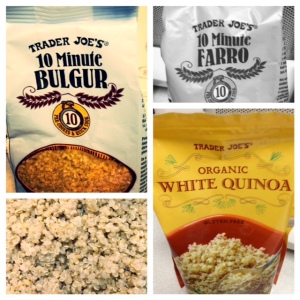ICYMI: Low Levels of ARSENIC Found in RICE, claims FDA
IN CASE YOU MISSED IT….
On September 6, 2013, the Food and Drug Administration (FDA) released a statement declaring the levels of arsenic found in rice are NOT significant enough to cause “any immediate or short-term adverse health effects” for consumers. Arsenic is a chemical naturally found in minor quantities in many foods we eat, but occasionally is found in larger amounts than safe. The FDA tests many food products that have had recent scares…remember the apple juice incident last year?
Although the FDA claims that the arsenic levels found in the 1,000+ samples of rice they tested are low enough to consume, they DID advise consumers to VARY the grains they consume to avoid overexposure.
So instead of rice, here’s a list of some other grains to include in your diet:
Quinoa: A personal favorite, and others agree! The Food and Agricultural Organization of the United Nations declared 2013 as “The International Year of the Quinoa,” but even past the new year, this whole grain superstar shouldn’t be going anywhere and you should be eating it on a regular basis. Packed with phytonutrients, quinoa serves a healthy dose of antioxidants, heart-healthy fats, and essential minerals great for your health for just over 200 calories per cooked cup.
- How to eat it: In addition to being a great salad-filler, try swapping traditional rice for quinoa in your next DIY burrito. In a high-fiber whole grain tortilla, wrap up black beans, quinoa, lettuce, tomato, and avocado for a filling and healthy whole grain (possibly gluten-free), protein-filled meal.
Amaranth: An ancient gluten-free superfood, a recent issue of Prevention magazine touted amaranth as “a mild nutty flavor and a great source of protein, calcium, magnesium, and iron.”
- How to eat it: Try it as an oatmeal alternative in the morning. In a 1:3 ratio amaranth to boiling water, reduce the heat and simmer for 20 minutes. Sprinkle with cinnamon, and a spoonful of your favorite nut-butter, and voila- a new breakfast fav!
Bulgar: Bulgar is on the heels of quinoa in the competition of my favorite grain. The 10-minute bulgar from Trader Joe’s is so easy to make and I believe has a brighter flavor than rice or quinoa. One cup of cooked bulgar has about 150 calories, 8g fiber, and almost 6g protein.
- How to eat it: Try swapping bulgar in my detox quinoa salad and let me know what you think! Or make your own pilaf with whatever veggies and fruit you have on hand.

- How to eat it: Barley makes a great base of a grain-centered salad and bulks up any pot of soup…perfect for soon-to-be fall!
Farro: Traditionally an Italian grain, farro is an up and coming superstar grain. It’s chewy, but firm texture makes it perfect as a salad base or in soups…just like barley!
Whole grain flours: We know whole grains are a first-class food, so be sure that they’re at the top of the ingredient list in your box of cereal, pasta, or breads!
Next time you’re at the supermarket pick up one of these other grains instead of rice to limit your arsenic exposure. Along with a varied diet, look out for “rice syrup” on packaged products, and if you’re making rice, be sure to rinse the grain before cooking. In addition, swap rice cakes for corn cakes to avoid extra arsenic exposure, but still keep the crunch in your lunch!
These whole grain superfoods should make an appearance in your diet, so get chomping!
-
Pingback: Exciting News + The #MeatlessMonday PROTEIN Story (How Much is Enough?) | C it Nutritionally





 Hi there!
Thanks for stopping by! I'm Chelsey, an online Registered Dietitian, recipe developer, budding photographer, and coffee addict! My mission is to help you feel good through food by answering the question "What should I eat?" Let's make nutrition approachable!
I hope you enjoy my personal collection of simple, healthy, food allergy friendly and nutritiously delicious recipes, plus tips and tons of tricks that will help YOU live a nutritionally-balanced life! I look forward to getting to know you better...
Hi there!
Thanks for stopping by! I'm Chelsey, an online Registered Dietitian, recipe developer, budding photographer, and coffee addict! My mission is to help you feel good through food by answering the question "What should I eat?" Let's make nutrition approachable!
I hope you enjoy my personal collection of simple, healthy, food allergy friendly and nutritiously delicious recipes, plus tips and tons of tricks that will help YOU live a nutritionally-balanced life! I look forward to getting to know you better...







